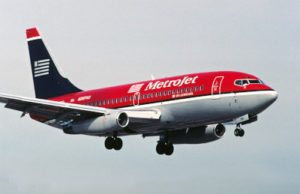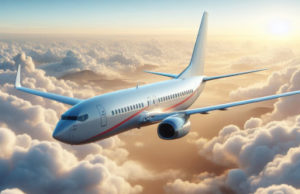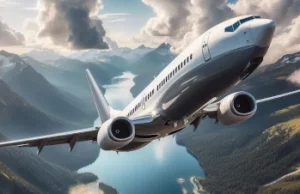About the 737 Boeing
Boeing 737 is the most common passenger airplane in the history of world aviation. Many aircraft corporations tried to create a competitor to the American airliner, but only the European concern Airbus succeeded almost 20 years after the 737 was launched.
Boeing 737 has been produced since 1966, and today, according to statistics, there are up to 1200 airplanes of this family in the air at the same time, and the well-known fact that every 5 seconds one 737 takes off somewhere in the world is very proud of the factory in Seattle.
The Boeing 737, which holds a place of honor in the world of civil aviation, is an integral part of the modern sky. This lightweight, narrow-body airplane created by Boeing has come to symbolize reliability and versatility in the world of passenger aviation.
With an impressive number of units produced, the Boeing 737 is firmly embedded in the history of air transportation. With its continuous short- and medium-range operation, this airplane provides not only efficiency but also comfort for millions of passengers.
The recognizable silhouette and distinctive sound of the Boeing 737 engines have become part of the soundscape of many airports. Its ease of operation and reliability have made it the aircraft of choice for many airlines, while its rugged design emphasizes its long service life.
Its ability to adapt to a variety of market conditions and needs allows the Boeing 737 to remain an integral element of world aviation.
History of the Boeing 737 Airliner
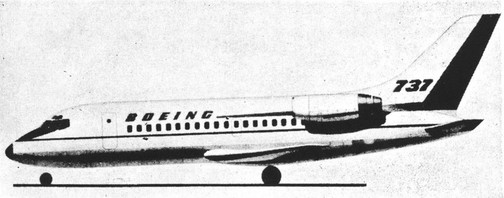
737 Boeing began to be developed in 1964. The airliner was supposed to impose the struggle against such medium-range airplanes as DC-9. But Boeing was lagging behind in the race: while the Boeing 737 was just being developed, the above-mentioned DC-9 was already being certified. In addition, the picture of the Boeing 737’s successful progress was spoiled by a «political» issue raised by pilots’ unions and other organizations, which insisted that such an airplane should be operated by a crew of three pilots or two pilots and a flight engineer. This was not favorable to the airlines, and the Boeing itself was not designed for three pilots. However, the pilots stood their ground, and the engineers had to redesign the cabin of the airliner.
Boeing 737 Design
The Boeing 737 design is based on the principles of aerodynamics, economy and safety. The airplane fuselage has a round shape, which provides strength and reduces air resistance. The wings are arrow-shaped and equipped with flaps that increase lift and controllability. The wingtips have winglets that reduce inductive drag and fuel consumption. The tailplane consists of vertical and horizontal stabilizers, which provide stability and balance of the aircraft. On the stabilizers there are rudders of altitude and direction, which allow to change the flight path.
737 Boeing airplane is equipped with two turbojet engines, which are located under the wings. The engines have a high thrust coefficient and low noise and emissions. The engines work in synchronization with the flight control system, which controls all flight parameters and ensures passenger safety and comfort. The flight control system consists of computers, sensors, instruments and knobs, which are located in the cockpit. The cockpit is equipped with six color TFT displays that show all necessary flight information¹.
The Boeing 737 aircraft has a spacious and comfortable passenger cabin, which can accommodate from 128 to 230 people depending on the configuration. The cabin has a modern design and is equipped with air conditioning, lighting, entertainment and communication systems. The cabin is divided into several classes of service, which differ in terms of comfort and price. The cabin also has toilets, kitchen, luggage lockers and emergency exits. The cabin meets all safety and hygiene requirements.
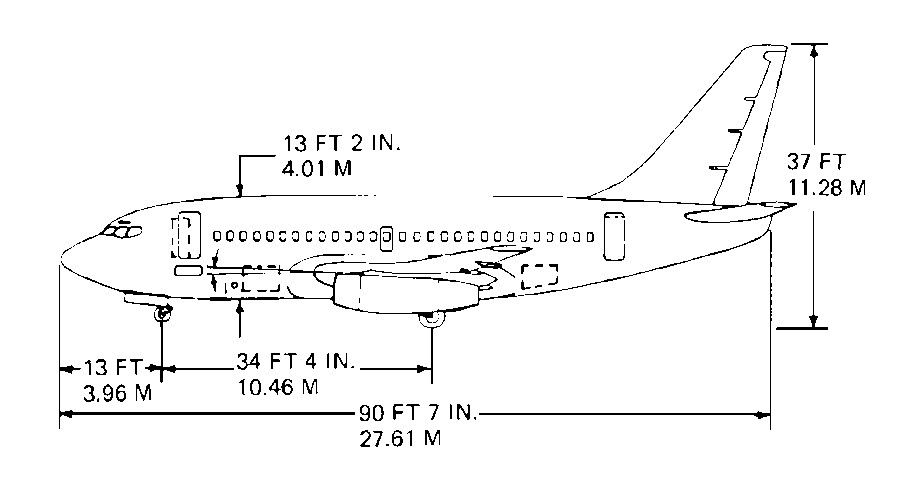
Boeing 737 Modifications
During its existence, the American corporation has released 4 generations of airplanes in several modifications. Familiarize yourself with them.
Generation Original
The Original generation includes two modifications. These are the Boeing 737-100 and the 737-200. Both models were released in 1967. The first is designed for short distances (about 2500 km), the second for longer flights (about 3500 km). The cabin capacity is 103 and 133 passenger seats respectively.
Classic Generation
The Classic generation includes 3 modifications. These are the 737-300, 737-400 and 737-500 models. The years of production are 1984, 1988 and 1990. The models are distinguished by the capacity of the cabin. The first is designed for 149, the second for 168 and the third for 132 passenger seats. The range of the 300 and 400 models is 5000 km, the 500th modification — 5200 km.
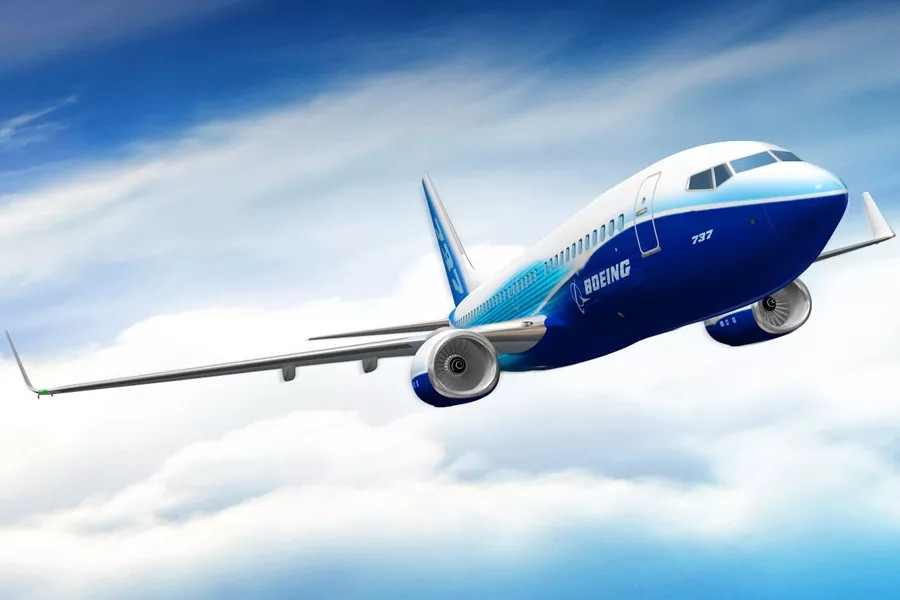
New Generation
The New Generation consists of 5 modifications. It includes such models as 737-600, 737-700/700ER, 737-800, 737-900 and 737-900ER. The years of production are from 1997 to 2007. They are designed for a range of 5200 km to 6230 km. Number of passengers — from 130 to 215 people.
MAX Generation
The MAX generation has three modifications so far. These are Boeing 737 MAX -7/8/9. The airplane was first introduced in 2016. The 7th model covers a distance of 7038 km, the 8th — 6570 km, and the 9th — 6570 km. The maximum cabin capacity is -172/200/220 passenger seats respectively.
737 Boeing Specs
| Model | 737-100 | 737-200 | 737-300 | 737-400 | 737-500 | 737-600 | 737-700 | 737-800 | 737-900 | 737-900ER |
|---|---|---|---|---|---|---|---|---|---|---|
| Length, m | 28.63 | 30.53 | 33.25 | 36.40 | 31.01 | 31.24 | 33.63 | 39.47 | 42.11 | 42.11 |
| Wingspan, m | 28.35 | 28.88 | 34.32 | |||||||
| Height, m | 11.23 | 11.07 | 12.67 | 12.62 | ||||||
| Fuselage Width, m | 3.76 | |||||||||
| Cabin Width, m | 3.54 | |||||||||
| Cabin Height, m | 2.19 | 2.11 | 2.20 | |||||||
| Max. Seats | 103 | 133 | 149 | 168 | 132 | 130 | 149 | 189 | 189 | 215 |
| Cruise Speed, km/h | 817 | 807 | 852 | |||||||
| Max. Speed, Knots | 350 | 350 | 330 | |||||||
| Range, km | 2592 | 3518 | 4176 | 3815 | 4398 | 5648 | 6230 | 5765 | 5800 | 5925 |
| Ferry Range, km | 3148 | 4444 | 6670 | 5000 | 5200 | 5648 | 6230 | 5765 | 5800 | 5925 |
| Ceiling, m | 10,670 | 10,700 | 11,300 | 11,300 | 12,500 | 12,500 | 12,500 | 12,500 | 12,500 | |
| Takeoff Length, m | 1290 | 2058 | 2012 | 2356 | 1860 | 1799 | 1677 | 2241 | 2408 | 2450 |
| Landing Length, m | 1180 | 1350 | 1400 | 1540 | 1360 | 1340 | 1430 | 1630 | 1700 | 1750 |
| Max. Takeoff Weight, kg | 43,998 | 45,359 | 56,472 | 62,823 | 52,390 | 56,245 | 70,080 | 79,015 | 79,000 | 85,200 |
| Empty Weight, kg | 26,581 | 27,170 | 31,479 | 33,189 | 31,311 | 36,378 | 37,648 | 41,413 | 42,901 | 44,677 |
| Fuel Capacity, liters | 13,399 | 13,096 | 20,102 | 20,102 | 20,102 | 26,022 | 26,022 | 26,022 | 26,022 | 26,025 |
| Fuel Capacity, kg | 10,758 | 10,515 | 16,141 | 16,141 | 16,141 | 20,894 | 20,894 | 20,894 | 20,894 | 20,894 |
| Specific Fuel Consumption, g/passenger-km | — | — | 25.5 | 20.9 | 25.5 | — | — | — | — | — |
| Engines | P & W JT8D-7 | P & W JT8D-9/9A | CFM56-3B1 | CFM56-3B2 | CFM56-3B1 | CFM56-7B18 CFM56-7B20 CFM56-7B22 | CFM56-7B20 CFM56-7B22 CFM56-7B24 CFM56-7B26 CFM56-7B27 | CFM56-7B24 CFM56-7B26 CFM56-7B27 | CFM56-7B24 CFM56-7B26 CFM56-7B27 | CFM56-7B24 CFM56-7B26 CFM56-7B27 |
| Thrust, t | 2 x 5.7 | 2 x 6.6 | 2 x 9.1 | 2 x 10 | 2 x 9.1 | 2 x 8.9 2 x 9.3 2 x 10.3 | 2 x 9.3 2 x 10.3 2 x 11.0 2 x 11.9 2 x 12.4 | 2 x 11.0 2 x 11.9 2 x 12.4 | 2 x 11.0 2 x 11.9 2 x 12.4 | 2 x 11.0 2 x 11.9 2 x 12.4 |
Boeing 737 Seat Map
The arrangement of the passenger cabin depends on the modification of Boeing, the characteristics and layout airlines can order separately. Most often there is a two-class variant, which consists of business and economy class. In the second place is an airplane with one economy-class cabin. The Boeing 737 seating capacity of the airliner ranges from 103 to 220 people.
Some airlines offer on the Boeing 737 first class service, giving passengers a luxurious and comfortable flight experience. First class often includes luxurious seats, superior service, high quality meals and many additional amenities.
The best seats are located in the forward part of the ship. Boeing 737 business class seats are usually concentrated near the main entrance. Many passengers choose this option because of the seats of increased comfort. On them, the flight takes place in the most comfortable conditions. In addition, passengers are offered free alcoholic beverages. This innovation has appeared recently.
The best Boeing 737 seating in terms of visibility are in the 2nd, 3rd and 4th rows, as they are not blocked by the wing. In this part of the airplane, passengers rarely move around the cabin, so a quiet flight is ensured. As for the economy class, the most popular are the Boeing 737 Seats of row 13. They are located near the emergency exit, so there is additional legroom. There are no restrooms nearby. Row 11-12 on the Boeing 737 Seat Map are more or less comfortable, but they do not have reclining seat backs.
Boeing 737 Business Class
The main advantage of business class is soft comfortable seats with a large reclining angle. There are from 2 to 5 rows in the forward section. Clients of the Boeing 737 Business Class can use the kitchen, which is installed in the front of the airplane. Toilets are also concentrated there. Seats of the 2nd and 3rd rows are the most quiet. The seats of the 1st row are the most «passable». The last row is close to the busy economy class. Very often they are separated only by a curtain. A typical cabin of this class Boeing-737 is several rows of 4 seats each. There are no special frills here, but passengers have some privileges.
They are the last to board and the first to disembark. Flight attendants provide a separate menu service. They dispose of outerwear and bring a welcome drink. A travel kit awaits passengers at their seats. Its configuration is determined by the airline. In the standard case it includes socks, slippers, napkins, toothbrush and toothpaste, etc. The main emphasis is placed on service and food. Passengers are provided with a plaid, a pillow, a personal table with a tablecloth and quality alcoholic beverages and snacks. There are no multimedia entertainment systems. But there is an additional luggage space.
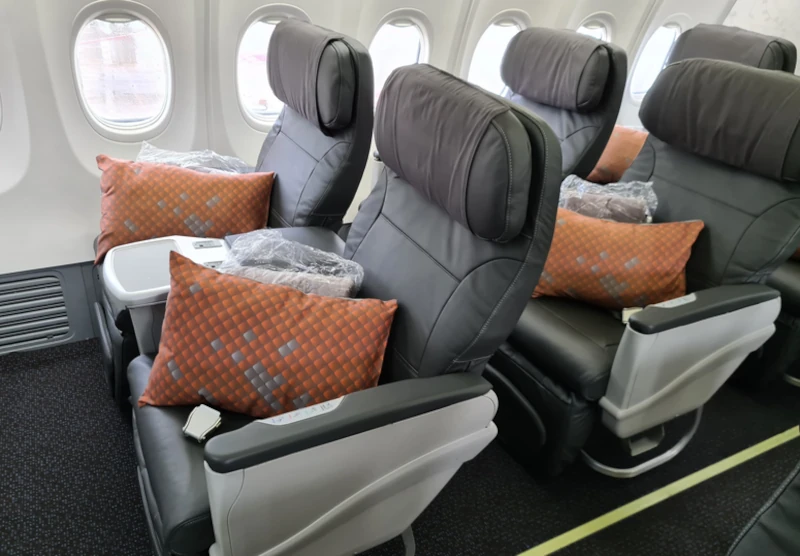

Economy Class
In the economy class cabin there are shelves for luggage above the seats. Kitchen and toilets are located in the tail of the Boeing 737. The first row seats and the seats near the emergency exits are the most comfortable, as there is more legroom. The most uncomfortable seats are concentrated in the last row. It is usually noisy, and the seat backs are characterized by a small reclining angle. There are 26 rows in economy class, with 6 seats in each row. Before buying tickets, take into account the fact that there is a blank wall in front of the 4th row. Still, these seats are preferred by passengers with children, as they are the first to be provided with food. And in front there are no neighbors who recline the seats and limit the space of passengers sitting behind.
Note that passenger service in this class is also at a high level. The choice of drinks is limited, but they are still available. Passengers carry no more than 20 kg of luggage — this is the main restriction. They are provided with plaid, hot meals, paninis, coffee, tea, juice. The free service includes the possibility of online check-in, a separate counter, increased luggage and hand luggage allowance. Economy class tickets are 2-3 times cheaper compared to business class tickets. Most people purchase them, especially if they are traveling short distances.

